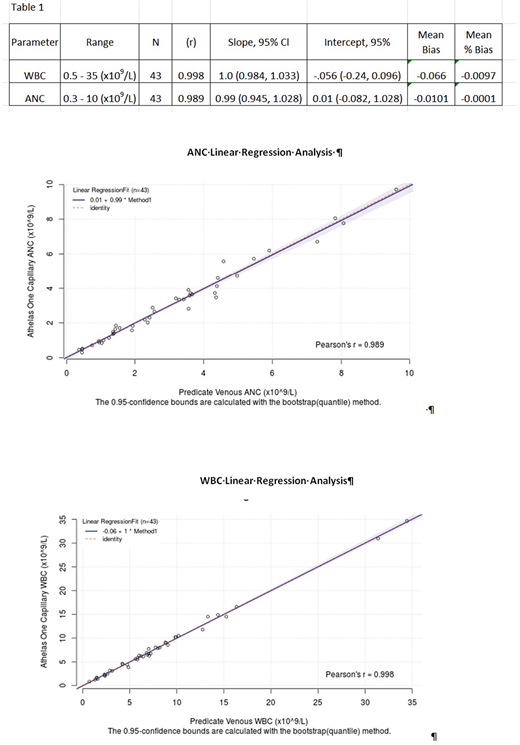Abstract
White blood cell counts (WBC) and absolute neutrophil counts (ANC) are well-established predictors of a patient's risk of fever and infections or febrile neutropenia (FN). Currently, patients at risk of FN due to cancer chemotherapy, idiosyncratic drug-reactions or congenital neutrophil disorders are monitored at hospital or clinic laboratories. For many patients, effective and frequent monitoring is difficult due to the time required and costs of repeated laboratory visits. We herein present the first results for a novel device called Athelas One, a miniature point-of-care hematology analyzer suitable for at home monitoring of WBC and ANC.
Methods: Athelas One (A1) is a small cylindrical device with a built-in, single head, light microscope. To determine the WBC and ANC, a small drop of blood (~ 3.5 uL) from a finger stick or an anticoagulated blood sample is drawn by capillary action onto a specially designed microfluidic test strip which creates a stained, precisely dimensioned monolayer of blood cells. The slide is then inserted into the device which scans the test strip and reports the WBC and ANC based on an image analysis process (Computer Vision). We compared results for A1 with a standard laboratory counter [Sysmex XE5000 (SX)].
Results: Initially, A1's reproducibility was demonstrated using 43 blood samples with a wide range of known WBCs (i.e., samples with normal counts, leukocytosis, leukopenia, neutropenia, neutrophilia) run on 4 devices using a single lot of test strips. The A1 results were then compared to SX results using the Passing Bablok Regression with Bootstrap method. These results showed strong linearity and comparability between paired anti-coagulated venous blood samples and the blood samples compared to finger prick capillary blood samples collected almost simultaneously. The slope and intercept indicated a linear relationship, with a 95% confidence for interval slope and intercept containing 1 and 0 respectively. (Comparisons: A1 blood to SX blood: WBC, r=0.998, ANC, r=0.989; A1 capillary to SX blood: WBC, r=0.998, ANC, r=0.97). Table 1 and Figure 1 show a summary of the comparisons. In addition to these results, we have tested 18 samples with WBC < 1.0 x 109/L with closely comparable results for A1 and standard hospital counter.
Summary: These initial results show that the WBC and ANC can be accurately determined with a finger stick drop of blood and this point-of-care hematology analyzer. Given its small size, ease of use and accuracy, the device is suitable for home monitoring.
Dale:Athelas, Inc.: Equity Ownership; Amgen: Consultancy, Research Funding; Sanofi-Aventi: Consultancy, Honoraria; Cellerant: Other: Scientific Advisory Board; Hospira: Consultancy; Prolong: Consultancy; Beheringer-Ingelheim: Consultancy; Coherus: Consultancy. Navarro-De La Vega:Athelas, Inc.: Employment. Parthasarathy:Athelas, Inc.: Employment, Equity Ownership. Bodapati:Athelas, Inc.: Employment, Equity Ownership, Patents & Royalties: patent owned by Athelas on the Athelas One device. Virey:Athelas, Inc.: Employment, Equity Ownership, Patents & Royalties: patent owned by Athelas on the Athelas One device. Moffatt:Athelas, Inc.: Employment, Equity Ownership, Patents & Royalties: patent owned by Athelas on the Athelas One device. Tandon:Athelas, Inc.: Employment, Equity Ownership, Patents & Royalties: patent owned by Athelas on the Athelas One device.
Author notes
Asterisk with author names denotes non-ASH members.


This feature is available to Subscribers Only
Sign In or Create an Account Close Modal